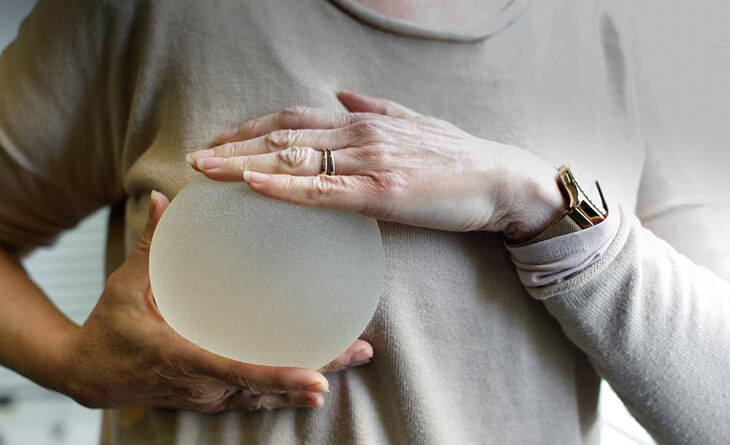Breast augmentation involves the use of silicone breast implants or your own fat to enhance the size of your breasts. This procedure can enhance under-developed breasts as well as restore breast volume following weight loss or pregnancy.

Am I a good candidate for this procedure?
You may be a good candidate for breast augmentation if:
- You feel that your breasts are naturally small and poorly developed and you want larger breasts
- Weight loss has changed the shape and size of your breasts
- Your breasts have become smaller and lost firmness after pregnancy
- One of your breasts is noticeably smaller than the other
Breast augmentation cannot completely correct severely droopy breasts. In such cases, you may require a combination of breast augmentation and breast lift / tightening surgery if you want larger and firmer breasts. While seeking Breast surgery, it is very important to inform your qualified Aesthetic surgeon surgeon if you or anyone in your family has had any prior history of breast cancer.
Brief information about breast implants
All breast implants are made of an outer silicone shell. They may be of various types based on:
1. The substance filling the implant
- Saline: silicon shell filled with saline to achieve the desired volume.
- Silicone: filled with medical grade silicone gel which feels very natural. (Present generation implants are filled with highly cohesive silicone gel which are extremely resistant to rupture and there is no leakage of the silicon gel).
2. The shape of implant
- Round: these are by far the most commonly used implants
- Anatomical (tear shaped): these mimic the natural breast contour
3. The surface of implant
- Smooth: the outer silicone shell is smooth.
- Textured: The outer silicone shell is roughened and grainy. “Micro” or “Nano”-textured implants are now available.
- Poly-urethane coated: shell coated with poly-urethane foam.
Choosing the correct implant size
Breast implants are available in various sizes; from 100cc to 1000cc (and even more but on demand). Choosing the correct size is no longer an arbitrary process, but a detailed and scientific one.
It could depend on “what size do you want to enlarge your breasts to?” For example, if you are presently a B cup and want to go to a C cup, then a 175-200cc implant would be adequate.
What implant is suitable and safe for you also depends on what your body can tolerate or accommodate. This is based on your individual tissue factors such as your chest width, existing volume of your breast tissue, amount of skin laxity, nipple position etc. Based on all these factors, a qualified Aesthetic surgeon is able to discuss your concerns and priorities with you and arrive at a mutual decision about the ideal breast implant size for you.
What are the important things to do before breast augmentation surgery?
The most important thing about planning your breast augmentation surgery is to choose the correct qualified Aesthetic plastic surgeon. More specifically, ensure that the chosen surgeon is routinely performing breast augmentation surgeries.
You must STOP the following medications approximately 2 weeks before surgery – blood thinners such as ecosprin, clopidogrel, warfarin etc, estrogen containing hormones, Vitamin E, ginseng, green tea, gingko balboa, garlic pearls, ayurvedic supplements. It is imperative that you completely stop smoking for a minimum of 1 week prior to your planned date of surgery as it can significantly increase your risk for anaesthesia as well as delay wound healing and increase your risk for post-surgery complications.
You will be advised a set of routine pre-operative investigations to ensure that you are fit for anaesthesia and surgery. A mammogram is also advisable prior to surgery to rule out any existing lumps or lesions in the breast. If you have a personal or family history of breast cancer, then a detailed baseline mammogram is mandatory to ensure absence of any existing lesion.
About the procedure
1. BREAST IMPLANT
The procedure is performed in an operation theatre under general anaesthesia.
Incisions are made in inconspicuous areas to minimize visible scarring. Most surgeons prefer the infra-mammary incision (under the breast) as it provides easy and optimum access, leads to natural looking results and results in a barely noticeable scar. The various incisions are shown below:

A pocket is then created either directly behind the breast tissue or under the pectoral muscle (a submuscular placement) (Fig C) or, over the pectoral muscle (a subglandular placement) (Fig B) or in the sub-fascial plane (Fig A), which is a modified plane over the pectoral muscle but under the breast tissue as well as under the pectoral fascia (distinct tissue layer covering the muscle). This decision is largely based on the available soft tissue and skin padding on the breast area.

The implant is then inserted into this pocket and smoothened into position such that the nipple areola complex is centralized over the implant. The incision is then closed in layers with self-dissolving sutures. A protective dressing is applied over the incision area and you will be advised to wear a supportive sports bra for 4-6 weeks. The surgery takes about 2 hours and it may be done as a day care procedure or with overnight stay.
2. FAT TRANSFER
This procedure is performed in an operation theatre under suitable anaesthesia.
The procedure involves three principal steps:
i) Harvesting of fat – Liposuction, commonly from abdomen, back or thighs, is done to collect fat usually using syringe liposuction techniques.
ii) Processing of fat – The harvested fat is allowed to sediment and sometimes centrifuged to separate the unwanted components such as fluid, blood and oil.
iii) Transfer of fat – The fat is then injected into the breasts using a cannula. Fat is injected as small droplets and in multiple planes (levels) so as to ensure greater survival rates. Ideally, fat is injected in the subcutaneous (under the skin) & sub-glandular (under the breast tissue, over the muscle) planes and not in the breast tissue itself (gland).
Advantages of fat transfer
- Fat can be injected in greater quantity in selected areas to achieve better results eg. more fat is injected in the upper pole of breast to achieve better upper pole fullness.
- No risk for allergic reactions or rejection since it is the patient’s own fat.
- No risk for capsular contracture, ALCL etc (complications related to implants).
- A touch up procedure can easily be added to further refine the result.

What to expect during recovery?
1. BREAST IMPLANT
You are likely to be sore for a day or two but you can be up and about after 24 hours. You will feel skin tightness in the area for a few weeks. The discomfort is controlled by oral medications. You will be advised to avoid any exercises & strenuous activities and to use a sports bra regularly for 4-6 weeks. You will not be allowed to sleep on the sides for 3 weeks and cannot sleep prone for at least 6 weeks. You must avoid sudden excessive stretching movements of the chest and shoulder.
A dressing change is usually done on the 4th/5th day and 8th/9th day. Washing the chest area will not be allowed for about 8-10 days. Stitches are almost always self-dissolving. Your surgeon will teach you to do a self-massage of your breast after 3 weeks. The scars will be firm and pink for at least 6 weeks after which they generally begin to fade.
Initially, the breasts may appear unnatural – high up on the chest and too firm to the feel. However, with time and with regular massaging, the implant and the surrounding capsule settles and the breast look and feel more natural. By around the 2 to 3-month stage after surgery, you can expect to see the final shape, size and feel of your augmented breasts. The scars will however take 3 to 6 months to settle.
Breast augmentation DOES NOT
- cause breast cancer
- affect fertility, pregnancy or breast feeding
You will be advised to follow-up with your plastic surgeon, preferably on an semi-annual basis. You may be advised an ultrasound every year and a mammogram every 2 years. You must immediately report to your plastic surgeon if there is any fresh development of pain or hardening in the breasts.
2. FAT TRANSFER
Fat Transfer to breasts may produce significant swelling that may take 7 to 14 days to settle. Bruising usually fades quickly and can be camouflaged by 7 days. Most people can return to work by 5 – 7 days. Oral medications will be prescribed to keep you comfortable.
Fat survival rates are unpredictable all over the world. You will therefore be informed preoperatively that you may require ssecondary sittings of fat transfer to achieve your desired result.
What can go wrong?
1. BREAST IMPLANT
As with any surgical procedure, breast augmentation with implants may be associated with various possible complications or unwanted effects. These may be as follows:
- Scar related complications: Noticeable scars, thickened scars.
- Implant related problems:
Seroma or hematoma – Fluid collections or clots immediately after surgery may require repeat surgery to clear up the fluid or blood collected and control the bleeding.
Infection – this is very rare and is generally managed with stronger antibiotics.
Skin necrosis or implant exposure – this may happen with very large implants placed in a tight space, in chronic smokers, uncontrolled diabetics, patients on steroids etc.
Persistent local pain – this too is quite rare and may be related to nerve impingement.
Implant malposition – this is particularly relevant with an anatomical implant which may rotate within its capsule.
Implant rupture – this is no longer a concern since implants are made of highly cohesive gel but extreme violence can still cause microtears in the implant.
Atrophy of breast tissue – Over years, the overlying breast tissue may undergo atrophy due to pressure from the implants, leading to the implant being visible or palpable. It is wise to avoid this issue altogether by selecting the correct implant size that the body can safely accommodate.
Palpable ripples – This is due to folds in the implant shell that become palpable. This was more common with saline implants.
Altered nipple sensation – this may involve either reduced nipple sensations or the nipples becoming extremely sensitive. Usually over a few months, these sequelae disappear.
Ptosis – the breast tissue and skin may stretch over time and is unable to hold the breast up, leading to sagging of breasts. This is more in the case excessively large implants.
Asymmetry – any pre-existing minor asymmetry tends to get amplified with the use of same sized implants. More significant size difference may be tackled by the use of different sized implants. Please discuss this in detail with your surgeon.
Capsular contracture – This manifests as hardening of the breast/s with or without pain due to the thickening and shrinkage of the capsule (smooth wall formed by the body around the implant). In the early stage, it may improve with massages and use of some medications. However, more severe cases may require surgery to remove the implant and either release the tightened capsule or excise it entirely. In such an eventuality, your Aesthetic surgeon will discuss with you, the pros and cons of replacing your implants at the same time or at a second stage 3-6 months later.
Breast implant associated Anaplastic large cell lymphoma (BIA-ALCL) – This is a type of rare lymphoma that develops within the capsule tissue. It is a very rare condition which is very easily treatable in the early stages. Please note that this is NOT Breast Cancer. The single most important issue to prevent advanced ALCL is early detection. BIA-ALCL most commonly presents as swelling in one breast. The other less common symptoms include hardening of one breast, an unusual persistent rash or a palpable mass in the breast or armpits. If you have any of these symptoms you must immediately contact your surgeon who may then advise further investigations. In most patients, BIA-ALCL is treatable by surgery – removing the implant AND the entire capsule.
Unsatisfactory sizing – sometimes patient may feel that the resultant breast size is either too small or too large as compared to their desire. This is better prevented by a detailed discussion, proper planning, use of sizers or use of computer software simulations. In spite of this, if the patient is still unhappy then repeat surgery with removal of the old implant and insertion of a new implant may be performed.
2. FAT TRANSFER
Specific fat transfer related potential complications are as follows:
• Under correction – this may be due to excessive absorption of fat or due to reduced survival of fat so that the resultant size is less than expected. This may require a second session of fat transfer to achieve the desired size.
• Fat necrosis, Cyst formation, calcification – Transfer of fat as large boluses may lead to inadequate survival of transferred fat. The fat cells that die may lead to the formations of fat necrotic cysts which may or may not get calcified. Patients feel these as firm to hard lumps in the breast a few weeks after the surgery. Small sized cysts may settle by themselves over time. Persistent cysts may require aspiration or surgical removal.
Fat transfer to breasts does not directly pre-dispose to development of breast cancer. However, the formation of cysts or calcification may mimic cancer on mammography. Therefore, an experienced radiologist must interpret mammograms after fat transfer to breasts so that the changes due to fat transfer can be differentiated from changes due to breast cancer.
